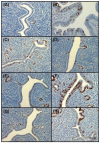Diarylheptanoid phytoestrogens isolated from the medicinal plant Curcuma comosa: biologic actions in vitro and in vivo indicate estrogen receptor-dependent mechanisms
- PMID: 19654927
- PMCID: PMC2717144
- DOI: 10.1289/ehp.0900613
Diarylheptanoid phytoestrogens isolated from the medicinal plant Curcuma comosa: biologic actions in vitro and in vivo indicate estrogen receptor-dependent mechanisms
Abstract
Background: Diarylheptanoids isolated from Curcuma comosa Roxb. have been recently identified as phyto estrogens. However, the mechanism underlying their actions has not yet been identified.
Objectives: We characterized the estrogenic activity of three active naturally occurring diarylheptanoids both in vitro and in vivo.
Methods: We characterized mechanisms of estrogenic action of the diarylheptanoids (3S)-1,7-diphenyl-(6E)-6-hepten-3-ol (D1), 1,7-diphenyl-(6E)-6-hepten-3-one (D2), and (3R)-1,7-diphenyl-(4E,6E)-4,6-heptadien-3-ol (D3) by using a real-time polymerase chain reaction assay, a mammalian transfection model, and a uterotrophic assay in mice.
Results: All diarylheptanoids up-regulated estrogen-responsive genes in estrogen-responsive breast cancer cells (MCF-7). In HepG2 cells transfected with estrogen receptor (ER) beta or different ERalpha functional receptor mutants and the Vit-ERE-TATA-Luc reporter gene, all diarylheptanoids induced transcription through a ligand-dependent human ERalpha-ERE-driven pathway, which was abolished with ICI 182,780 (ER antagonist), whereas only D2 was active with ERbeta. An ERalpha mutant lacking the functional AF2 (activation function 2) region was not responsive to 17beta-estradiol (E(2)) or to any of the diarylheptanoids, whereas ERalpha lacking the AF1 domain exhibited wild-type-like activity. D3 markedly increased uterine weight and proliferation of the uterine epithelium in ovariectomized mice, whereas D1 and D2 were inactive. D3, like E(2), up-regulated lactoferrin (Ltf) gene expression. The responses to D3 in the uterus were inhibited by ICI 182,780. In addition, D3 stimulated both classical (Aqp5) and nonclassical (Cdkn1a) ER-mediated gene regulation.
Conclusions: The results suggest that the D3 diarylheptanoid is an agonist for ER both in vitro and in vivo, and its biological action is ERalpha selective, specifically requiring AF2 function, and involves direct binding via ER as well as ERE-independent gene regulation.
Keywords: Curcuma comosa; ER dependent; ERE dependent; ERE independent; diarylheptanoid; estrogen-regulated genes; uterotrophic activity.
Figures







References
-
- Brzozowski AM, Pike AC, Dauter Z, Hubbard RE, Bonn T, Engstrom O, et al. Molecular basis of agonism and antagonism in the oestrogen receptor. Nature. 1997;389:753–758. - PubMed
-
- Chun KS, Sohn Y, Kim HS, Kim OH, Park KK, Lee JM, et al. Anti-tumor promoting potential of naturally occurring diarylheptanoids structurally related to curcumin. Mutat Res. 1999;428:49–57. - PubMed
-
- Couse JF, Curtis SW, Washburn TF, Lindzey J, Golding TS, Lubahn DB, et al. Analysis of transcription and estrogen insensitivity in the female mouse after targeted disruption of the estrogen receptor gene. Mol Endocrinol. 1995;9:1441–1454. - PubMed
Publication types
MeSH terms
Substances
Grants and funding
LinkOut - more resources
Full Text Sources
Other Literature Sources
Miscellaneous

